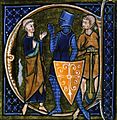Gentry facts for kids
Gentry means "well-born people." The word comes from the Latin word gentis, which means "clan" or "extended family." In England, gentry was a social class just below the aristocracy. These families usually got their money from owning large amounts of land.
Contents
What is the Gentry?
The gentry were a group of people who had high social standing. They were not nobles like dukes or counts, but they were still very important. Their status came from their family background and their wealth. This wealth often came from owning land.
Land and Wealth
Gentry families owned large landholdings. This meant they had big farms or estates. They often rented out parts of their land to farmers. The money they earned from these rents helped them live a comfortable life. Owning land was a sign of power and influence. It allowed them to live without working a regular job.
Social Status and Lifestyle
Being part of the gentry meant you had a certain lifestyle. They often lived in large country houses. They were expected to be educated and polite. Many gentry members were involved in local politics or served as justices of the peace. This meant they helped keep law and order in their areas. They also often held positions in the military or the church.
Gentry in England
In England, the gentry played a big role in society. They were often the local leaders in their communities. They were different from the aristocracy because they did not have hereditary titles like "Lord" or "Duke." However, they were still above the common people, like farmers or merchants. Over time, some gentry families became so wealthy and powerful that they were able to join the aristocracy.
Related Social Classes
Understanding the gentry helps us learn about other social groups.
- The aristocracy were the highest social class, usually with inherited titles.
- Nobility is a broader term for people with high rank, often including the aristocracy.
- Feudalism and Manorialism were systems where land ownership determined power. The gentry were an important part of these systems.
Images for kids
-
Cleric, Knight, and Peasant archetypes represent the virtues of prudence, fortitude, and temperance, respectively. In Classical antiquity and Christendom, prudence and fortitude were seen as the cardinal virtues that should govern society.
-
This part of a 12th-century Swedish tapestry has been interpreted to show, from left to right, the one-eyed Odin, the hammer-wielding Thor and Freyr. This triad corresponds closely to the trifunctional division: Odin is the patron of priests and magicians, Thor of warriors, and Freyr of fertility and farming.
-
Europe and the Byzantine Empire 1000 CE
-
Thomas Jefferson's home, Monticello, in Virginia, was the seat of his plantation.
-
Matsue daimyō (c. 1850s)
-
Hungarian nobles, circa 1831
-
An example of an Elizabethan pedigree of the de Euro family of Northumberland, barons of Warkworth and Clavering. Scrivened, circa 1570 to 1588
See also
 In Spanish: Gentry para niños
In Spanish: Gentry para niños












